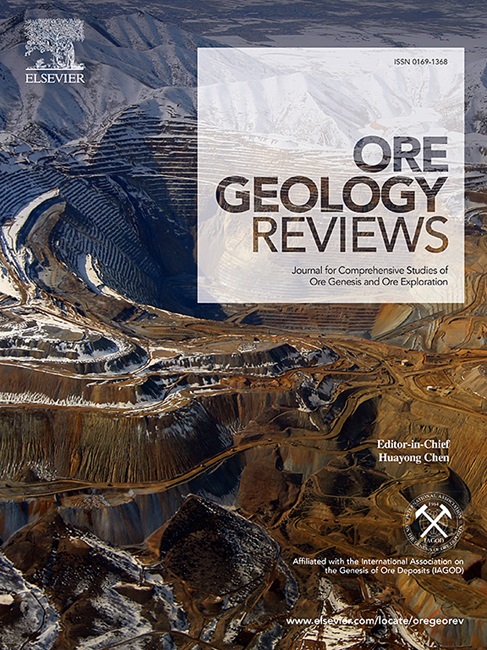青藏高原褶皱推覆带中偶发性流体迁移形成的密西西比河谷型铅锌矿床
IF 3.2
2区 地球科学
Q1 GEOLOGY
引用次数: 0
摘要
密西西比河谷型铅锌矿床主要赋存于前陆盆地和造山带的褶皱冲断带,形成于中低温、高盐度条件下。冲断带的矿床一般形成于早期碰撞后的走滑或伸展阶段的褶皱地层中,与前陆盆地的矿床具有不同的水文和构造控制作用。以唐古拉冲断带和多柴马矿床为研究对象,建立了二维简化模型,采用有限元方法研究了地形梯度和断层对流体运移和温度变化的控制作用。进一步讨论了模拟结果对冲断带MVT成矿作用的启示和预测,包括成矿持续时间、成矿流体源-输运-汇聚过程、成矿位置和成矿规模的控制因素等。结果表明,流体从造山带向盆地的运移受地形梯度的驱动。在整个过程中,流体沿剥离断层和中央断层向地表运移。流体在中心带不稳定,而是向前带迁移。成矿流体到达前带后,沿断裂迅速上升,进入浅层构造并成矿。监测点的温度变化表明流体有周期性上涌。模拟温度与成矿温度一致。假设构造条件不变,矿化时间在240 ~ 550 kyr,计算流体体积为1.4 × 106 ~ 2.8 × 106 m3。高渗透断层聚集了高温高速流体,为成矿提供了必要的热流通道,限制了MVT矿床的成矿范围和成矿时间。该模拟研究为预测MVT矿床的矿化分布和规模提供了良好的指示。本文章由计算机程序翻译,如有差异,请以英文原文为准。

Mississippi valley-type Pb–Zn deposits formed by episodic fluid migration in the fold-and-thrust belts of the Tibetan Plateau
Mississippi Valley-type (MVT) Pb–Zn deposits are typically found in the foreland basins and fold-and-thrust belts of orogens, and they form under low–moderate temperatures and high salinities. Deposits in thrust belts typically form in folded strata during strike–slip or extensional stages following early collision, indicating different hydrologic and tectonic controls from deposits in foreland basins. On the basis of the Tanggula thrust belt and the Duocaima deposit, we established a 2D simplified model and employed the finite element method (FEM) to investigate how topographic gradient and faults control fluid migration and temperature changes. We further discuss the implication and prediction of simulation results for MVT mineralization in thrust belts, such as the duration of mineralization, the source–transport–convergence processes of ore-forming fluid, and the factors controlling the metallogenic location and scale. The results indicate that the fluid that migrates from the orogen toward the basin is driven by topographic gradient. Throughout this process, the fluid migrates along the detachment fault and central faults to the surface. The fluid does not stabilize in the central belt but migrates toward the front belt. When the ore-forming fluid reaches the front belt, it ascends rapidly along faults, enters the shallow structure and mineralizes. The temperature variations at the monitoring points indicate episodic upwelling of the fluid. The simulated temperatures correspond to the metallogenetic temperatures. Assuming that structural conditions remain constant, mineralization may be completed within 240–550 kyr, and the calculated fluid volumes are 1.4 × 106–2.8 × 106 m3. High-permeability faults gather high-temperature and high-velocity fluid, acting as conduits that provide the necessary heat and flow for mineralization, thus limiting the metallogenic range and time of MVT deposits. This simulation study provides a good indication for the prediction of the distribution and scale of mineralization of MVT deposits.
求助全文
通过发布文献求助,成功后即可免费获取论文全文。
去求助
来源期刊

Ore Geology Reviews
地学-地质学
CiteScore
6.50
自引率
27.30%
发文量
546
审稿时长
22.9 weeks
期刊介绍:
Ore Geology Reviews aims to familiarize all earth scientists with recent advances in a number of interconnected disciplines related to the study of, and search for, ore deposits. The reviews range from brief to longer contributions, but the journal preferentially publishes manuscripts that fill the niche between the commonly shorter journal articles and the comprehensive book coverages, and thus has a special appeal to many authors and readers.
 求助内容:
求助内容: 应助结果提醒方式:
应助结果提醒方式:


